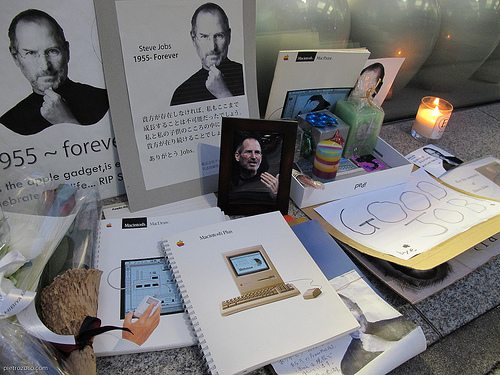
© peitrozuco.com
The recent passing of Steve Jobs, the inventor and entrepreneur behind Apple and Pixar, at the tender age of 56 reminds us not just how young computer technology, but also how much an individual can change the world.
In 1984, when I was singing “Girls Just Wanna Have Fun” into my hair brush, drooling over Tom Selleck in Magnum PI, and discovering lycra (aerobics with Jane Fonda, anyone?), Jobs and his pal Steve Wozniak had just released the first Apple Mac, the grandparent of all our IT gadgets today.
Jobs was a controversial figure, as seen in the dramatically mixed responses to his death — some obituaries have hailed his charismatic leadership and brilliant sales technique, while others have slammed his erratic personality and perfectionist tendencies. Whichever you believe, Steve Jobs had powerful entrepreneurial qualities, which make a valuable lesson for those of us trying to make our mark in small business.
Seek knowledge
Jobs was still in high school when he started going to after-school lectures at Hewlett-Packard. He may have formally dropped out of college in 1972 after one semester, but continued taking non-assessment classes in subjects as diverse as calligraphy and from 1975, attended meetings of a hobbyist group called the Homebrew computer club.
These activities may seem minor, but they resulted in life-changing opportunities and relationships, including a summer job at Hewlett-Packard, where he met Steve Wozniak, as well as relationships with future Silicon Valley high rollers. Even that calligraphy class proved useful — without it, Jobs once said, our computers would have only one typeface and font!
Think outside the square
You may not think the hippie era and IT have a lot in common, but Jobs’ desire to learn about life took him to India in 1974 at the age of 19, where new experiences gave him a fresh perspective and a new way of thinking. Apart from converting to Buddhism and developing a penchant for bare feet, he came home with:
- A desire to change the world
- A belief in simplicity, which meant focusing on what is important
- The ability to say “no” in order to maintain that focus
Choose your people
“Many hands make light work,” the saying goes and Jobs knew he needed specialists, people with skills beyond his own, to make Apple a success.
He first showed a flair for putting his ego on hold and choosing a team to deliver results as an employee at Atari, not long after returning from India. Offered $100 for each chip he could remove from the arcade game “Breakout”, Jobs offered Wozniak half the reward to do the technical work.
In the end, Atari paid the pair just 14% of what they earned, but had inadvertently introduced them to the third founding member of Apple, Ronald Wayne, a fellow employee. Wayne may have left Apple only two weeks after it started in 1976, but, 20 years older than Jobs, he gave the company the maturity to start up.
Become an innovator
Innovators have the unusual gift of foreseeing and setting trends — they can see what their market needs when the market itself sees no gap. And this was one of Jobs’ key skills.
Let me give you a bit of history…. Not that long ago, computers were command-driven; that is, the user sat in front of a screen and typed text-based instructions to get results. For example, you typed the words “erase” or “save” to get your computer to do these things. Talk about fussy and time-consuming… no wonder only “geeks” used computers! Then a division of Xerox developed a system called “graphical user interface” (GUI) which allowed the user to tell the computer what to do by using a mouse to click on icons, navigate through windows, scroll through menus and check boxes.
Sound familiar?
Xerox didn’t see the potential of their innovation, but Jobs did and he was the first person to apply it to the personal computer, the Apple Mac. So as you go to the next web page, send an email, write a report, play Solitaire or download photos from your camera, think of Steve Jobs… who made computers accessible to everyone and allowed us to get a lot more done with a simple click of the mouse.



